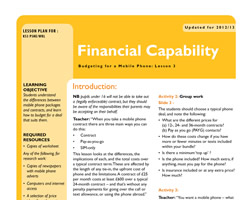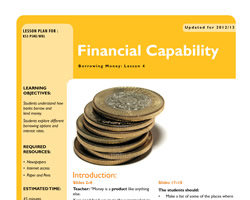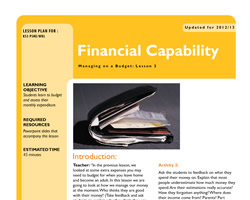PSHE Lesson Plans / KS4 - Financial Capability
KS4 - Financial Capability
A series of financial capability lessons for key stage 4, including worksheets and PowerPoint presentations. Further lessons will be available soon.
These 45-minute lesson plans are designed to allow a non-expert teacher to present the different concepts in terms that young people will appreciate and relate to - and then explore, in pair or group-work, the various ideas and options.
-
 TRS PSHE Finance Lesson 2 PDF
TRS PSHE Finance Lesson 2 PDF
-
 TRS PSHE Finance Lesson 2 PPT
TRS PSHE Finance Lesson 2 PPT
-
 TRS PSHE Finance Lesson 1 PDF
TRS PSHE Finance Lesson 1 PDF
-
 TRS PSHE Finance Lesson 1 PPT
TRS PSHE Finance Lesson 1 PPT

Students understand the differences between mobile phone packages and contracts, and learn how to budget for a deal that suits them.
-
 TRS PSHE Finance Lesson 3 PDF
TRS PSHE Finance Lesson 3 PDF
-
 TRS PSHE Finance Lesson 3 PPT
TRS PSHE Finance Lesson 3 PPT

Students understand how banks borrow and lend money. Students explore different borrowing options and interest rates.
-
 TRS PSHE Finance Lesson 4 PDF
TRS PSHE Finance Lesson 4 PDF
-
 TRS PSHE Finance Lesson 4 PPT
TRS PSHE Finance Lesson 4 PPT
Financial Capability Lesson Plans
The PSHE financial capability lesson plans are very flexible – depending on the abilities of the class or individuals, the timetable, and the wider curriculum, they can be extended or broadened out to include many other subjects.
Maths is an obvious extension on many occasions, but a wide range of additional work can be built into most of the sessions, including art, drama, English, history, or geography.
Team work is encouraged at many points, and this potentially allows pupils’ presentation skills to be practised and developed, as well as providing a competitive element for some of the activities. Individual activities such as crossword puzzles and word searches are also provided to ensure vocabulary is embedded.
The materials are not prescriptive – they can be freely adapted by teachers to suit local needs.
These materials are designed to help young people appreciate the concept of ‘money’ – how it has developed from basic bartering to the modern banking system. We explore the issues of paying for things – that everything has a price, and we need to accumulate enough money to obtain these items and budget accordingly.
We look at the concepts of saving, investing and lending money, on the one hand – and borrowing money, on the other. Investing (and the relative risks) and interest rates are considered, and different sources of credit explored – with an indication of their relative costs.
Whole-life costs of, eg, mobile phone contracts are considered, to help young people consider the implications of headline rates of “Only £10 a month” – ie what is the real cost over the two years of a typical phone contract. Similarly with credit – what is the total cost of a credit card, a payday loan, or a loan for a car.



